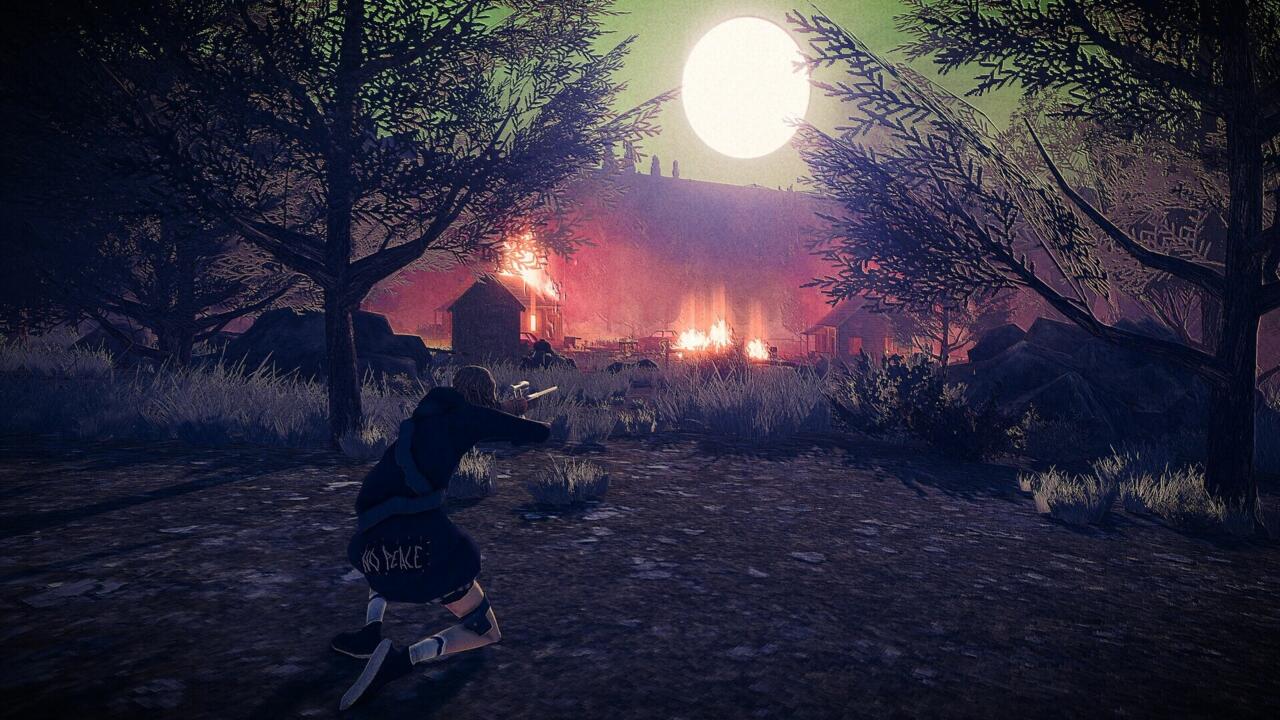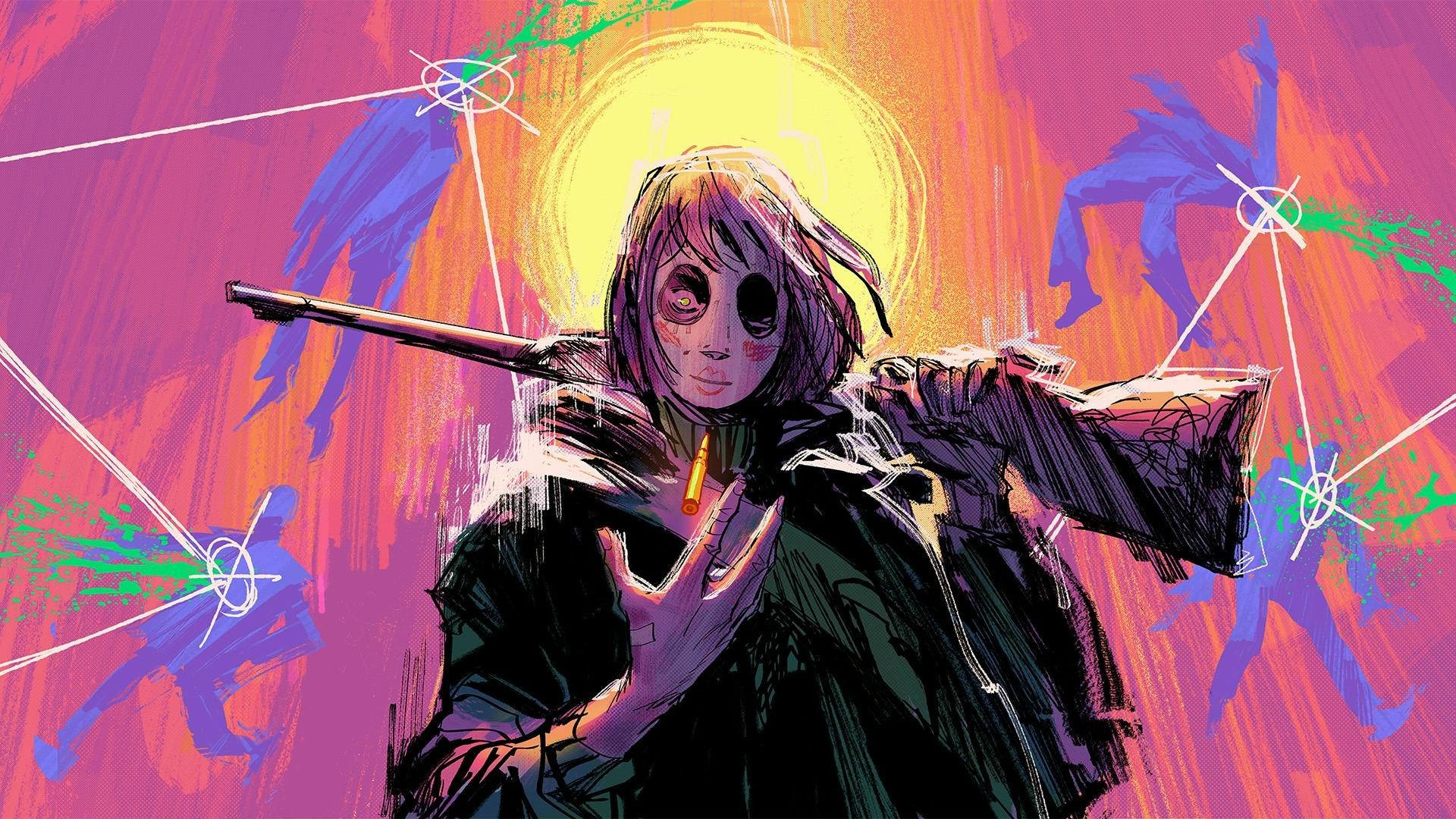It only takes a single bullet to burn down an empire. That’s the ethos behind Children of the Sun, an excellent supernatural puzzle-shooter from solo developer René Rother and publisher Devolver Digital. Like many of the games in Devolver’s vast library, Children of the Sun is wonderfully stylish, violent, and built on a unique gameplay hook; think Sniper Elite mixed with Superhot and you’re on the right track without quite telling the whole story.
You play as a protagonist known simply as The Girl, a one-woman wrecking crew waging a vengeful war against the eponymous cult that ruined her life. As one cultist after another is turned to mincemeat behind the vindictive crosshairs of your sniper rifle, you gradually make your way up the food chain until coming face-to-scope with your true target: The Leader. While embarking on this blood-soaked killing spree, hand-drawn flashbacks reveal tidbits about the atrocities committed by this mysterious cult and The Girl’s reasons for seeking revenge.
There’s no dialogue during these cutscenes; instead, the narrative is intentionally minimalist, bombarding you with unnerving memories that are both terse and chaotic. This scattershot approach makes it difficult to glean all of the available information–perhaps deliberately so–which means you might feel lost and slightly detached from the story at times. It’s all complemented by a discordant soundscape of ambient white noise that matches the game’s striking art style–composed of deep purples and vivid yellows–and gritty, surreal tone. The game’s arresting aesthetic paints a picture of a brutal world of saturated filth, where cultists defile seedy motels, gloomy forests, and derelict apartment buildings, spreading their deceitful disease like plague-infested rats.
For as evocative as Children of the Sun’s story, visuals, and music are, it’s the innovative gameplay where it truly shines. At the beginning of each level, you’re able to move The Girl either left or right on a predetermined path. Sometimes, you can navigate around a level in a full 360-degree circle, while other times, you may only be able to move a few yards before being impeded by a fallen tree or steep riverbank. From here, you can get a lay of the land, mark enemies, and determine the best position to fire from. Once you’ve aimed down the scope and pulled the trigger, the camera snaps to the crown of the bullet as it hurtles through the air. Blood spatter and disintegrated flesh usually follow, but the catch is that this is the only shot you’ll fire for the duration of the level.
The Girl’s backstory pulls from a classic fiction trope where a young girl discovers she has latent supernatural powers once she reaches puberty. Each time a bullet is propelled through a cultist’s skull, time slows down to a crawl, and The Girl’s psychic abilities let you take control of the round and re-aim, allowing a single bullet to cleave through an entire enemy compound in one fell swoop.
Initially, you can only move the bullet in a straight line from one enemy to the next, ping-ponging between them like a murderous pinball machine, and this makes your first shot the most crucial. From that initial point of impact, you need to chart a course through every other enemy until none are left alive. This is easier said than done, of course. While some enemies remain stationary, others are walking around, circling the entire map in a car, and sitting out of view of your initial vantage point. Considering all of this, you might have to finish a level by ensuring that the penultimate kill provides a clear sightline of the final cultist, who was hidden until now. There are wrong ways to do this, but there isn’t a definitive right way, so experimentation is incentivized and rewarded.
Children of the Sun is wonderfully stylish, violent, and built on a unique gameplay hook; think Sniper Elite mixed with Superhot and you’re on the right track without quite telling the whole story
As you progress through the story and more enemy types are introduced, you’re given additional powers to counteract the likes of shielded and armored cultists and the increasingly elaborate environments they’re inhabiting. The first of these powers lets you take direct control and gently curve bullets like James McAvoy in the 2008 film Wanted. This is useful for firing over walls and bending the shot so it lurches downwards and hits the cultist on the other side, or simply tweaking the bullet’s trajectory to guarantee it lands on-target.
Another ability reveals enemy weak points, which, when destroyed in a hail of slow-motion blood, grant you the power to redirect the bullet in mid-flight. Using this, you can fire past a shield-wielding enemy and then spin the bullet around to nail them in the back of the head, entirely negating their bullet-proof protection. Other times, you might use this technique to escape a building and re-enter it elsewhere or fire into the sky to provide a better view of the area and uncover a previously elusive enemy.
Armored cultists, meanwhile, provide an altogether different challenge. The only way to penetrate their thick armor is by using a power shot–achieved by holding down the trigger for the duration of the bullet’s flight. These shots necessitate a large enough distance between targets to build up the requisite velocity needed to blow through armor, so figuring out how to remove these enemies is a unique problem. Doing so is always a thrill, though, as you get the gratification of seeing the bullet reach supersonic speeds before blasting through the cultist’s now-useless defense.
Finding a solution to each level’s grisly puzzle is immensely satisfying, especially when trial and error is abundant. Your first few attempts might revolve around tentatively exploring to find where all of the cultists are located and then figuring out the best way to carve through each one. You can sometimes use the environment to your advantage, too, shooting vehicles’ fuel caps and gas canisters to eliminate multiple enemies in one vehement explosion. You could blow up a car just to attain a better angle or snipe a pigeon flying overhead to gain a bird’s eye view of the area. I wish there were more opportunities for environmental kills besides destroying vehicles and explosive barrels, but restricting how you can interact with the world around you adds to the challenge and sense of achievement when you emerge victorious.

At around three hours in length, Children of the Sun is a relatively brief experience. Usually, this would be a blessing in disguise for a game that doesn’t diversify from its core conceit too often, yet I still found myself desperate for more. Fortunately, replayability is rife, as the game’s scoring system encourages you to go back and replay previous levels to achieve a better rating. Headshots are scored differently from leg wounds, just as you earn more points for better timing and efficiency, while leaderboards create a sense of competition. Completing a level also reveals an excellent snapshot of the flight path of your bullet, which the game makes easy to share on social media for some extra fulfillment.
Children of the Sun’s unconventional approach to sniping is consistently thrilling and wholly satisfying. It might be full of gruesome blood spatter and cracked skulls, but it’s also the thinking person’s shooter–more of a delightfully macabre puzzle game than anything else. It’s admittedly short, and the game’s longevity will largely depend on how hard you fall for its inventive and bloody puzzles. That shouldn’t be a problem when it’s so difficult not to. And even if it’s relatively one-note, Children of the Sun plays that note with such morbid aplomb that it’s easy to recommend.






